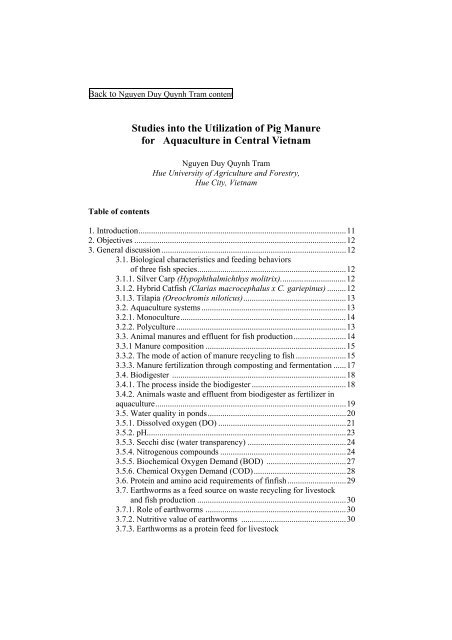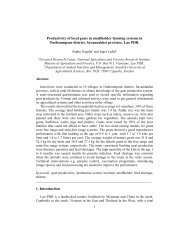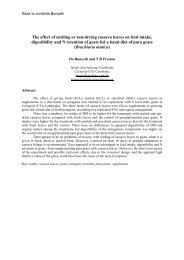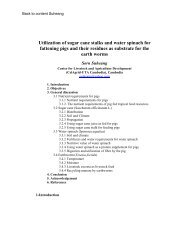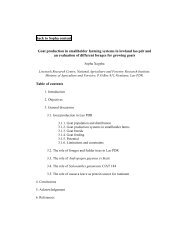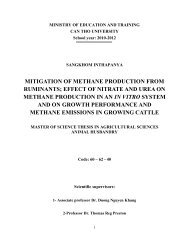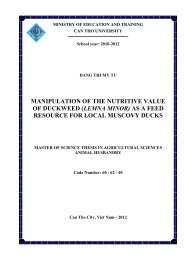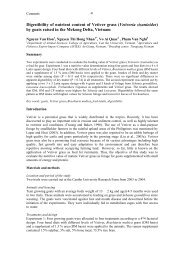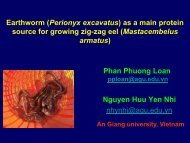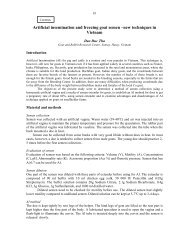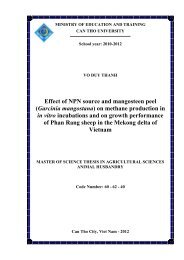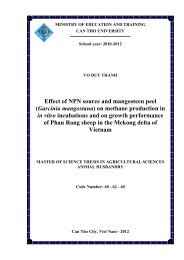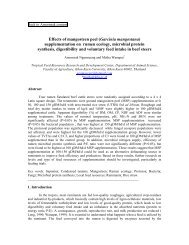Back to Nguyen Duy Quynh Tram content - MeKarn Project
Back to Nguyen Duy Quynh Tram content - MeKarn Project
Back to Nguyen Duy Quynh Tram content - MeKarn Project
You also want an ePaper? Increase the reach of your titles
YUMPU automatically turns print PDFs into web optimized ePapers that Google loves.
<strong>Back</strong> <strong>to</strong> <strong>Nguyen</strong> <strong>Duy</strong> <strong>Quynh</strong> <strong>Tram</strong> <strong>content</strong><br />
Table of <strong>content</strong>s<br />
Studies in<strong>to</strong> the Utilization of Pig Manure<br />
for Aquaculture in Central Vietnam<br />
<strong>Nguyen</strong> <strong>Duy</strong> <strong>Quynh</strong> <strong>Tram</strong><br />
Hue University of Agriculture and Forestry,<br />
Hue City, Vietnam<br />
1. Introduction...................................................................................................11<br />
2. Objectives .....................................................................................................12<br />
3. General discussion ........................................................................................12<br />
3.1. Biological characteristics and feeding behaviors<br />
of three fish species.......................................................................12<br />
3.1.1. Silver Carp (Hypophthalmichthys molitrix)...............................12<br />
3.1.2. Hybrid Catfish (Clarias macrocephalus x C. gariepinus) .........12<br />
3.1.3. Tilapia (Oreochromis niloticus).................................................13<br />
3.2. Aquaculture systems .....................................................................13<br />
3.2.1. Monoculture...............................................................................14<br />
3.2.2. Polyculture.................................................................................13<br />
3.3. Animal manures and effluent for fish production.........................14<br />
3.3.1 Manure composition ...................................................................15<br />
3.3.2. The mode of action of manure recycling <strong>to</strong> fish ........................15<br />
3.3.3. Manure fertilization through composting and fermentation ......17<br />
3.4. Biodigester ...................................................................................18<br />
3.4.1. The process inside the biodigester .............................................18<br />
3.4.2. Animals waste and effluent from biodigester as fertilizer in<br />
aquaculture...........................................................................................19<br />
3.5. Water quality in ponds..................................................................20<br />
3.5.1. Dissolved oxygen (DO) .............................................................21<br />
3.5.2. pH...............................................................................................23<br />
3.5.3. Secchi disc (water transparency) ...............................................24<br />
3.5.4. Nitrogenous compounds ............................................................24<br />
3.5.5. Biochemical Oxygen Demand (BOD) ......................................27<br />
3.5.6. Chemical Oxygen Demand (COD)............................................28<br />
3.6. Protein and amino acid requirements of finfish............................29<br />
3.7. Earthworms as a feed source on waste recycling for lives<strong>to</strong>ck<br />
and fish production .......................................................................30<br />
3.7.1. Role of earthworms ...................................................................30<br />
3.7.2. Nutritive value of earthworms ..................................................30<br />
3.7.3. Earthworms as a protein feed for lives<strong>to</strong>ck
and fish production ....................................................................31<br />
4. Conclusions...................................................................................................32<br />
5. Acknowledgements.......................................................................................33<br />
6. References.....................................................................................................34<br />
Paper I<br />
Paper II
Appendix<br />
This thesis is based on the following papers, which are referred <strong>to</strong> in the<br />
text by their Roman numerals І, II.<br />
I. <strong>Tram</strong>, N. D. Q., Ngoan, L. D., and Ogle, B., 2004. Effect of processing pig<br />
manure through a biodigester as fertilizer for fish ponds on water quality and<br />
growth performance of three fish species.<br />
II. <strong>Tram</strong>, N. D. Q., Ngoan, L. D., and Ogle, B., 2004. Culturing earthworms on<br />
pig manure and the effect of replacing trash fish by earthworms on the growth<br />
performance of Hybrid Catfish (Clarias macrocephalus x Clarias gariepinus).
1. Introduction<br />
Aquaculture is the cultivation of aquatic animals and plants. Its primary aim is <strong>to</strong> produce<br />
aquatic food organisms for human consumption, but includes other purposes such as the<br />
cultivation of ornamental and aquarium fishes (Egna, 1997). According <strong>to</strong> FAO (1995) the <strong>to</strong>tal<br />
capture fisheries of the world peaked at about 90 million metric <strong>to</strong>ns in 1989 and so aquaculture<br />
will become increasingly important in the future. Aquaculture is usually sustainable because it<br />
normally makes use of locally available resources. Integration of aquaculture with other forms of<br />
agriculture diversifies farm productivity. This, in turn, provides opportunities for intensified<br />
production with more efficient allocation of land, water, labor, equipment and other limited inputs<br />
than enterprises which are independently operated. S<strong>to</strong>red pond water may serve as a catalyst for<br />
rural development because a variety of activities may be simultaneously undertaken. For example<br />
fish culture integrated with garden irrigation, lives<strong>to</strong>ck watering, and various domestic uses are<br />
all possible. (www.ag.auburn.edu/icaae/intraqua.htm).<br />
Fresh water fish culture has in many ways with a diversification of cultured species (Grass Carp,<br />
Common Carp, Silver Carp, Bighead Carp, etc) and applied-aquaculture production systems<br />
(VAC system, fresh water fish culture in reservoirs, rice-fish culture system, running system, etc).<br />
Demand for aquaculture products for food and export is increasing and aquaculturists are trying<br />
<strong>to</strong> increase production in various ways. One technical application for the appropriate use of<br />
available resources <strong>to</strong> increase cultured fish production is fertilization. There are many kinds of<br />
potential fertilizers for fish pond fertilization, including inorganic fertilizer and organic fertilizer<br />
(manure, green fertilizer, sewage) in which manures from lives<strong>to</strong>ck are used more often. Farmers<br />
usually apply manure directly <strong>to</strong> the fish ponds, which is not appropriate as it causes water<br />
pollution, fish disease and eutrophication because of the high organic matter <strong>content</strong>. Lives<strong>to</strong>ck<br />
excreta are frequently a source of environmental pollution in intensive, specialized animal<br />
agriculture. In contrast, the efficient recycling of manure in integrated farming systems can lead<br />
<strong>to</strong> increased profits and reduced environmental damage. To solve the problem of pollution from<br />
animal excreta, there are several techniques that can be applied at present. The plastic biodigester<br />
is one of the most efficient technologies for small-scale animal farms because of its low cost, fast<br />
payback, simplicity and positive effect on pollution (Bui Xuan An, et al., 1997) The main<br />
products from the biodigester are biogas and effluent, which is a potential fertilizer because the<br />
anaerobic digestion process results in conversion of organic nitrogen from manure <strong>to</strong> ionized<br />
ammonia (NH4 + ), which can be used directly by plant roots. Thus it has been found in Vietnam<br />
that effluent was a better fertilizer compared with raw manure for application <strong>to</strong> cassava and<br />
duckweed (Le Ha Chau, 1998), although there are few reports of trials <strong>to</strong> compare the two<br />
sources of plant nutrients. It is also important <strong>to</strong> note that biodigester effluent, as well as behaving<br />
as organic fertilizer, also contains the organic materials from the digestion of bacteria that fish<br />
can use as food <strong>to</strong> grow. Increased productivity in polyculture fish ponds when biodigester<br />
effluent, rather than manure, was used as fertilizer was reported by Han Yuqin and Ding Jieyi<br />
(1984), and yields of fish were increased by 26% when the effluent was applied compared with<br />
the original manure.<br />
However, organic wastes from lives<strong>to</strong>ck, plant and vegetable industries are becoming<br />
increasingly difficult and expensive <strong>to</strong> dispose of using conventional technology. Waste<br />
management using earthworms is an increasingly attractive option, with earthworms being<br />
commercially produced on a large scale using organic waste. To achieve this organic wastes from<br />
cattle and pigs may require solid separation from slurry, and poultry waste requires composting,<br />
washing or ageing <strong>to</strong> remove inorganic salts and ammonia. However, horse manure, paper waste,<br />
paper pulp solids, brewery waste and spent mushroom compost require no further modification.<br />
Urban waste including food scraps and grass clippings are suitable for earthworms, but are best<br />
fed after mulching and mixing <strong>to</strong> produce a uniform feed s<strong>to</strong>ck (Edwards and Bohlen, 1996). The<br />
worms themselves can also be fed <strong>to</strong> chickens as a high quality protein supplement (Rodríguez et
al., 1995). Earthworms are also important in improving the quality of soil by recycling decaying<br />
material, and are also a source of protein for other animals. The cultivation of earthworms using<br />
local resources such as lives<strong>to</strong>ck manure would seem <strong>to</strong> be a valuable intervention for the<br />
improvement of living standards of smallholders in the countryside. This research is aimed at<br />
finding the most suitable way of utilizing manure <strong>to</strong> develop fresh water fish culture and increase<br />
the incomes of rural people in Central Vietnam.<br />
2. Objectives<br />
• To evaluate the effect of fresh pig manure and biodigester effluent on physico-chemical<br />
and biological parameters of pond water and on the growth of three fish species (Tilapia,<br />
Silver Carp and Hybrid Catfish) in a polyculture system, thus providing data on the<br />
integration of fresh water aquaculture and biogas utilization.<br />
• To evaluate the nutritive value of earthworms in replacing trash fish as a protein source<br />
for growing Catfish.<br />
3. General discussion<br />
3.1. Biological characteristics and feeding behaviors of three fish species<br />
3.1.1. Silver Carp (Hypophthalmichthys molitrix)<br />
Silver Carp live in the upper layer and are active jumpers. They grow in river tributaries,<br />
and spawn in the main river. Silver Carp feed mainly on plank<strong>to</strong>n with their gill rakers. In the<br />
larval stage, they filter zooplank<strong>to</strong>n but switch <strong>to</strong> phy<strong>to</strong>plank<strong>to</strong>n when the gill rakers are properly<br />
developed (Sifa li et al., 1994).<br />
3.1.2. Hybrid Catfish (Clarias macrocephalus x C. gariepinus)<br />
Hybrid Catfish are characterized by omnivorous feeding, fast growth, simple artificial<br />
propagation and high disease resistance. Catfish can be grown in monoculture or in polyculture<br />
systems. They can also be reared in small tanks in highly intensified culture systems. The Catfish<br />
has an accessory respiration organ, so it can survive when dissolved oxygen is low, or even out of<br />
water for several days. This species characteristic enables it <strong>to</strong> survive in highly stressed<br />
environments, which other species cannot <strong>to</strong>lerate (Sifa li et al., 1994).<br />
3.1.3. Tilapia (Oreochromis niloticus)<br />
Tilapia originated in Africa and were introduced <strong>to</strong> many areas in the world.<br />
Oreochromis niloticus (Nile Tilapia), Oreochromis mossambicus (Black Tilapia) and<br />
Oreochromis aureus (Blue Tilapia) are the most common suitable cultivated species. Tilapia are<br />
more <strong>to</strong>lerant <strong>to</strong> poor water quality than most commonly cultured fish. This is an important<br />
reason for the successful culture of these fish in many different kinds of system. Tilapia are an<br />
excellent culture species, partly because they grow well on a variety of natural food organisms,<br />
including plank<strong>to</strong>n, green leaves, benthic organisms, aquatic invertebrates, larval fish, detritus,<br />
and decomposing organic matter (Schroeder, 1978).
Table 1. Feeding habits of some fish species<br />
Feeding habit Species<br />
Algae and plank<strong>to</strong>n Silver Carp (Hypophthalmichthys<br />
molitrix)<br />
Milkfish (Chanos chanos)<br />
Sarotherodon galileus<br />
Sarotherodon niloticus<br />
Grey mullet (Mugil cephalus)<br />
Zooplank<strong>to</strong>n Bighead Carp (Aristichthys nobilis)<br />
Macrophytes Grass Carp (Ctenopharyngodon idella)<br />
Benthos Common Carp (Cyprinus carpio)<br />
Black Carp (Mylopharyngodon piceus)<br />
Mud Carp (Cirrhina moli<strong>to</strong>rrela)<br />
Detritus Sarotherodon aureus<br />
Common Carp (Cyprinus carpio)<br />
Milk fish (Chanos chanos)<br />
Sarotherodon niloticus<br />
3.2. Aquaculture systems<br />
In general, there are two forms of fish culture: monoculture and polyculture. Each system<br />
has its own important characteristics and the decision as <strong>to</strong> which system <strong>to</strong> use will depend on<br />
the purpose of the operation. Mostly, fish are raised in polyculture systems for extensive and<br />
semi-intensive culture, while monoculture is the choice for intensive systems.<br />
3.2.1. Monoculture<br />
Monoculture, which is practiced in many countries, is the s<strong>to</strong>cking of a single species in a<br />
pond. Within a monoculture system, there are several s<strong>to</strong>cking practices that affect the fish<br />
production of a pond. Monoculture is generally not as popular in extensive and semi- intensive<br />
cultivation systems as it is in intensive culture. In intensive culture the fish are confined in a small<br />
volume, such as in cages and concrete ponds, and derive all their sustenance from high protein,<br />
processed feeds. In such cases, a specially developed feed is provided for a specific species of<br />
fish. Where fish are raised primarily on natural food sources, monoculture results in ineffective<br />
utilization of several levels of the pond’s natural food chain.<br />
Nevertheless, some of the highest yields observed in integrated systems have been<br />
achieved in monoculture. High yields of the Nile Tilapia, Oreochromis niloticus, for instance, in<br />
waste-fed ponds, suggest such a system is practical.<br />
3.2.2. Polyculture<br />
A fish pond, especially a fresh water pond, usually produces a variety of food organisms<br />
in different layers of the water. Therefore, s<strong>to</strong>cking species (or different sized classes of a given<br />
species) that have complementary feeding habits, or that feed in different zones, will efficiently<br />
utilize space and available food in the pond and increase <strong>to</strong>tal fish production. Moreover <strong>to</strong><br />
maximize fish production with available food organisms in ponds, polyculture, with a variety of<br />
fish in different feeding niches, has been commonly practiced (Ling, 1967; Olah, 1980). Tang<br />
(1970) described multispecies polyculture as a harmonious system where the available fish foods<br />
and s<strong>to</strong>cked fish species are balanced.
Chinese fish culturists usually polyculture the following fish: (1) Grass Carp (C<strong>to</strong>nopharyngodon<br />
idellus) which roams in all strata of the water and feeds mainly on higher aquatic plants; (2)<br />
Silver Carp (Hypothalmichthys molitrix), a midwater dweller that prefers phy<strong>to</strong>plank<strong>to</strong>n as food;<br />
(3) Bighead Carp (Aristichthys nobilis), also a midwater dweller, which consumes zooplank<strong>to</strong>n;<br />
(4) Black Carp (Mylopharyngodon piceus), a bot<strong>to</strong>m-dwelling carnivore that feeds on molluscs;<br />
and (5) Mud Carp (Cirrhinus motilorella), a bot<strong>to</strong>m-dwelling omnivore that feeds on benthic<br />
animals and detritus. Grass Carp is the major species usually s<strong>to</strong>cked when plants are abundant in<br />
the pond. In plank<strong>to</strong>n-rich ponds, Silver Carp and bighead Carp are the major species usually<br />
s<strong>to</strong>cked. In deeper ponds, the productivity of the bot<strong>to</strong>m water is substantially reduced and the<br />
s<strong>to</strong>cking rate of the bot<strong>to</strong>m dwellers is usually low.<br />
Based on these theories and practices the fish used in our study were raised culture in a<br />
polyculture with three fish species (Hybrid Catfish, Silver Carp and Tilapia) in order <strong>to</strong> improve<br />
the efficiency of utilization of natural foods (Paper I)<br />
3.3. Animal manures and effluent for fish production<br />
The use of animal manures for fish culture is an extension of traditional land-crop<br />
cultivation, which uses available on-farm resources within reach of many small-scale farms in<br />
Asia (Zhu et al., 1990; Edwards, 1993). It is well recognized that pond fertilization with animal<br />
manures stimulates production of bacteria, phy<strong>to</strong>plank<strong>to</strong>n, zooplank<strong>to</strong>n, and benthos. The obvious<br />
advantages of using animal manures as a nutrient source for fish culture are that they are (1)<br />
relatively inexpensive, (2) readily available on-farm, and (3) suitable for a variety of fish in<br />
polyculture. This procedure mitigates the problem of solid waste disposal. However, there are<br />
also a number of negative aspects of using animal manures. There are aesthetic objections and<br />
sanitary concerns related <strong>to</strong> the fish products from manured ponds also it is time-consuming <strong>to</strong><br />
collect and apply bulk materials <strong>to</strong> ponds on a routine basis. These procedure results in<br />
unpredictable nutrient quality and high biochemical oxygen demand, which may cause oxygen<br />
depletion of pond water when applied at high rates. It is unsuitable for intensive, high-yield<br />
culture systems.<br />
3.3.1. Manure composition<br />
A large variety of animal manures have been used <strong>to</strong> fertilize fish ponds. In general, the<br />
moisture and nutrient <strong>content</strong>s of manure vary considerably, depending on fac<strong>to</strong>rs such as the<br />
diet, purity and treatment of manure, and duration and conditions of s<strong>to</strong>rage. In our study, manure<br />
from pigs fed a mixture of concentrate and maize as fed (<strong>content</strong> 20% CP) had a mean <strong>content</strong> of<br />
N of 3.1% in DM (Paper I). The quality of manures depends on their composition, as they are<br />
often mixed with decomposed animal manure, plant residues and lime. In many instances animal<br />
manure may contain a significant amount of spilled animal feed, which contributes directly <strong>to</strong> the<br />
fish’s diet when applied <strong>to</strong> the pond (Kwei Lin, 1997). The typical composition of the manures of<br />
various lives<strong>to</strong>ck species is shown in Table 2.<br />
Table 2. Average composition of manure from different lives<strong>to</strong>ck species<br />
Composition, % of DM<br />
Moisture N P K<br />
Dairy cows 79 0.5 0.1 0.5<br />
Fattening cattle 78 0.7 0.2 0.5<br />
Sheep 64 1.1 0.3 1.1<br />
Pigs 74 0.5 0.2 0.4<br />
Hens 76 1.1 0.4 0.4
Source: Schroeder, 1980<br />
DM = dry matter<br />
3.3.2. The mode of action of manure recycling <strong>to</strong> fish<br />
Feeding animal wastes <strong>to</strong> fish is an old practice. The mechanism of manure fish recycling<br />
via fish is illustrated in Figure 1.<br />
O2<br />
Inorganic plant<br />
nutrients<br />
Light /<br />
pho<strong>to</strong>synthesis<br />
Macrophytes<br />
1982)<br />
Solubilization<br />
in water column<br />
Applied organic fertilizer/animal manure<br />
Algae Zooplank<strong>to</strong>n<br />
Microbial<br />
Colonization/decomposition<br />
New microbial / bacterial<br />
biomass<br />
Direct consumption<br />
Cultured fish/shrimp<br />
Waste/ excreta<br />
and death<br />
O2<br />
Benthic animals<br />
Direct<br />
consumption<br />
Figure 1. Fate of applied organic fertilizer in aquatic systems (Adapted from Edwards,<br />
The fish is the final result of a complex biological cycle. The chain or cycle of natural<br />
fish production includes the following links: (a) mineral nutrients- plant production; (b) microbial
production (c) intermediate animal consumption and production leading <strong>to</strong> the final product<br />
which is the fish; and (d) reduction. The origin of this cycle lies in the mineral nutrients of water<br />
which come from soluble substances, carried <strong>to</strong> the water by exogenous detritus (animal waste)<br />
and also by rainfall. By means of pho<strong>to</strong>synthesis, the green vegetation transforms these inorganic<br />
substances in<strong>to</strong> organic matter which forms vegetable tissue (higher and lower plants). Living or<br />
dead, the plants are consumed by numerous small animals. These then serve as a food for larger<br />
water animals which in turn are eaten by fish, either directly or after death and decomposition.<br />
The last stage is the reduction, which is brought about by bacteria. Bacteria, by a<br />
mineralization mechanism permit the return in solution of all dead components of organic mattervegetable<br />
and animal-and their re-integration in<strong>to</strong> the biological cycle.<br />
The production of a fish pond depends, in the final analysis, on the production of<br />
vegetation, which in turn is dependent on the nutrients found in the pond. The vegetable growth<br />
of the fish pond can be increased by introducing fertilizers and animal manures.<br />
3.3.3.Manure fertilization through composting and fermentation<br />
Decay<br />
under<br />
water<br />
Gases →<br />
Peat<br />
Anaerobic<br />
decomposition<br />
Natural<br />
Guts of<br />
Animals<br />
Manure<br />
Organic wastes<br />
Digester<br />
Sludge<br />
Aerobic<br />
decomposition<br />
Artificial Natural Artificial<br />
Plant wastes<br />
Animal bodies<br />
dung piles<br />
Bio-gas Ammonia<br />
Carbon dioxide<br />
Open compost<br />
piles<br />
Ammonia<br />
carbon dioxide<br />
Humus ←solids<br />
Figure 2. End products of organic decay (Fry, 1976)<br />
In many parts of the world organic manures and wastes are first biologically stabilized by<br />
aerobic composting or by anaerobic fermentation prior <strong>to</strong> application as pond fertilizers. Both<br />
these stabilization processes rely on the controlled microbial decomposition of an organic waste<br />
substrate; the former (composting) in the presence of atmospheric oxygen, and the latter<br />
(fermentation) in the absence of atmospheric oxygen (Figure 2). The rationale behind the use of<br />
these stabilization techniques is <strong>to</strong> speed up the natural decomposition process and so reduce the<br />
time lag between fertilizer application and increased natural productivity. Apart from yielding<br />
useable by-products such as heat energy (composting) and biogas (mixture of methane and<br />
carbon dioxide; anaerobic fermentation), these stabilization techniques permit the use of<br />
agricultural wastes which in their natural or undecomposed state would have a low fertilizer value
(such as coffee pulp, sugar cane waste, rice straw, palm oil waste, etc), facilitate the destruction<br />
of potentially hazardous pathogens and parasites which may be present in the raw waste material<br />
(ie. human faecal wastes), reduce the bulk weight of the original waste material, and also reduce<br />
the oxygen demand of the stabilized waste when applied <strong>to</strong> a water body.<br />
3.4. Biodigesters<br />
Biodigester technology for converting manure in<strong>to</strong> methane for fuel is neither new nor<br />
uncommon. In many parts of Asia, Central America and Europe, biodigester use is widespread.<br />
Biodigesters are installed in these areas in response <strong>to</strong> organic waste (manure) disposal problems<br />
and/or high-energy costs (Halter, www.csale.usask.ca/PDF Documents/biodigesterDevelop.pdf)<br />
3.4.1. The process inside the biodigester<br />
The process of bio-digestion is the collection of organic material in<strong>to</strong> a containment<br />
body, which is isolated from the external environment. Within this body a microenvironment<br />
optimal for methanogenic bacteria (methanogens 1 ) is provided. These methanogens digest<br />
organic material (in this case manure) and emit CH4 gas and NPK slurry 2 (NPK concentrate 3 and<br />
grey water 4 ). This process greatly reduces the emission of volatiles 5 normally associated with<br />
manure and converts the solids in<strong>to</strong> a more uniform sterilized product. Carbon that normally<br />
would be released in the form of gaseous hydrocarbons, CO2 and CH4, is contained and burnt as<br />
fuel <strong>to</strong> heat the barn and biodigester. If the gaseous hydrocarbons are burnt in a microturbine 6 ,<br />
then electricity <strong>to</strong> power the barn and biodigester facilities can also be generated. The residual<br />
heat from the microturbine is available <strong>to</strong> maintain a consistent climate within both barn and<br />
biodigester (see Figure 3).<br />
1 Methanogens are anaerobic bacteria, which digest organic material and release methane as a<br />
byproduct.<br />
2 NPK slurry refers <strong>to</strong> the liquid material that has passed through the biodigester. It is a mixture<br />
which, when separated, constitutes NPK concentrate and grey water.<br />
3 refer <strong>to</strong> a product that can be used as input for the production of a commercial product like<br />
compost.<br />
4 Grey water is the water that is removed from the NPK slurry. This water might be purified <strong>to</strong><br />
potable standards,<br />
however, this has yet <strong>to</strong> be verified by independent study.<br />
5 For this report volatiles are gaseous substances like NH3, CH4, CO2, or N2O which are emitted<br />
from manure.<br />
6 Microtubine: For this report shall refer <strong>to</strong> a small, portable gas-fired electricity generating plant<br />
of 75kW capacity.
Inputs<br />
Feed<br />
Barn Biodigester<br />
Energy Pigs<br />
Manure<br />
Figure 3. Biodigester Schematic<br />
Outputs<br />
CH4<br />
NPK<br />
Grey<br />
3.4.2. Animals waste and effluent from biodigester as fertilizer in aquaculture<br />
Organic waste utilization in aquaculture can either be extensive, with wastes occurring<br />
naturally or being added, with little or no further production management (Bardach et al., 1972).<br />
An example is a duck farm where the wastes can produce up <strong>to</strong> 1.3 <strong>to</strong>ns fish/ha in 100 days.<br />
In China, when animal wastes are applied there is often additional extraneous feeding<br />
(Ding Jieyi and Han Yujin 1984). In these situations, the 100-day fish yield reaches 3 <strong>to</strong> 4<br />
<strong>to</strong>ns/ha. Moscoso and Nava (1990) reported that in a Tilapia pond fertilized with effluent, the<br />
fish production was 2290 kg/ha in 154 days. The fish yield in study by San Thy and Pres<strong>to</strong>n<br />
(2003b) was 1015 kg/ha in 120 days. In a polyculture fish farm in Israel, yields were reasonably<br />
high (4150 kg/ha/yr). It should be noted that in polyculture systems, nutrients are reused directly<br />
as they pass through the digestive tracts of the various component species (Rawitscher and<br />
Mayer, 1977). The use of manure and domestic sewage, however, represents a saving for the fish<br />
farmer only when these materials are locally available. Overall productivity of biomass was<br />
increased by 67 % with no additional feeding or fertilizer by providing pig wastes <strong>to</strong> a polyculture<br />
pond. It was also found (Paper I) that in a polyculture with three fish species (Hybrid Catfish,<br />
Silver Carp and Tilapia) applied raw pig manure or effluent from a biodigester gave a <strong>to</strong>tal net<br />
fish yield of 2.1 and 1.7 <strong>to</strong>ns/ha, respectively.<br />
Hogan (1933) and Meehean (1934) showed an increase in the production of fish due <strong>to</strong><br />
fertilization, and Judy and Schloemer (1938) found that both plank<strong>to</strong>n abundance and fish growth<br />
rate increased after the application of fertilizers. Howell (1942) concluded that fertilization led <strong>to</strong><br />
increase in plank<strong>to</strong>n abundance and fish production. Smith and Swingle (1943) also studied the<br />
effects of both inorganic and organic fertilizers on plank<strong>to</strong>n life and found an increase in plank<strong>to</strong>n<br />
as well as fish production. Hepher (1962) conducted experiments on the fertilization of fish ponds<br />
in Israel for ten years and found positive effects on the growth of fish. Similarly,<br />
Biodigesters have been suggested as a way <strong>to</strong> alleviate pollution concerns as well as<br />
offering new revenue opportunities. These opportunities are realized via the fertilizer resource.<br />
One product of bio-digestion is the conversion of raw manure slurry in<strong>to</strong> enriched NPK fertilizer.<br />
Relative <strong>to</strong> raw manure, the enriched NPK concentrate has more available nutrients, is relatively<br />
odourless, is free of disease, germs, weeds and seeds and is less prone <strong>to</strong> cause water<br />
contamination (Hazeltine and Bull, 1999 cited by Halter, www.csale.usask.ca/PDF Documents
iodigesterDevelop.pdf). Hence, the digested product is characterized by greater consistency and<br />
minimizes offensive odours. In effect, a biodigester is an environment that transforms carbon and<br />
hydrogen in the raw slurry in<strong>to</strong> gaseous CH4 for combustion. The remaining liquid mixture is<br />
sterilized and rendered in<strong>to</strong> a consistent NPK concentrate via bacterial activity. The liquid NPK<br />
fertilizer can then be de-watered <strong>to</strong> become NPK concentrate. The latter process adds significant<br />
value since water is heavy and expensive <strong>to</strong> transport. When water is removed only the nutrientrich<br />
solids remain and can be transported longer distances at less cost. The residual “grey” water<br />
can possibly be used <strong>to</strong> flush manure from the barns in<strong>to</strong> the biodigester. These fac<strong>to</strong>rs combine<br />
<strong>to</strong> alleviate the problem of excessive fertilization close <strong>to</strong> the hog barns and opens opportunities<br />
for hog manure in the higher value residential compost market. Injection is a method of manure<br />
application that uses an apparatus similar <strong>to</strong> an air seeder <strong>to</strong> place manure below the surface.<br />
3.5. Water quality in ponds<br />
The various chemicals dissolved in the water, as well as the temperature and other<br />
physical attributes of water, all combine <strong>to</strong> form what is called water quality. For aquaculture<br />
systems, changes in water characteristics that improve the production of an aquatic crop would be<br />
considered improvements in water quality, while those changes reducing production would be<br />
considered as degradation of water quality (Diana et al., 1997). Water quality is one of the most<br />
important fac<strong>to</strong>rs affecting successful pond fish culture. If water quality is excellent, then<br />
survival, growth, and reproduction can achieve high values; otherwise fish production will be<br />
reduced or impossible. Some of the more commonly cultured warm water pond fish species are<br />
relatively <strong>to</strong>lerant of poor water quality. They can exist and grow over a wide range of salinity<br />
and temperature, and can <strong>to</strong>lerate low oxygen concentrations for brief periods (Table 3) (Fast,<br />
1983). These species were undoubtedly selected by early aquaculturists for their hardiness.<br />
Table 3. Temperature and dissolved oxygen values for selected warm water pond fishes a<br />
Temperature, o C<br />
Min Optimum Max<br />
Min, Oxygen,<br />
References<br />
mg/l<br />
Clarias Catfish 20 29-32 37<br />
5(fry), 0.0<br />
(adult)<br />
Doudoroff and<br />
Shumway, 1970<br />
Tilapia 10-15 25-33 35-42 0.2-2.0<br />
Balarin and Hat<strong>to</strong>n,<br />
1979<br />
Silver Carp 15 20-28 30 0.3-1.1` Hickling, 1962<br />
Cyprinus carpio<br />
Common Carp, Grass<br />
0-3 20 36 0.2-2.8<br />
Doudoroff and<br />
Shumway, 1970<br />
Carp, Bidhead Carp<br />
and Silver Carp<br />
21 27-29 32 0.5 Bortz et al., 1977<br />
a Temperature values are generally for long - term periods (e.g. months), whereas minimum<br />
oxygen values are generally for less than one day.<br />
3.5.1. Dissolved oxygen (DO)<br />
Dissolved oxygen concentration is one of the most important water-quality parameters.<br />
Oxygen depletion is usually the principle cause of sudden, massive fish kills. Maintaining a<br />
‘normal’ or desirable oxygen regime in a pond not only helps assure the fish’s health, but also<br />
indicates that the pond system is functioning suitably. A productive pond will typically have
supersaturated DO during the late afternoon, and undersaturated DO at dawn. We can better<br />
understand how DO depletion occurs in a fish pond if we describe the interactions between the<br />
main variables which result in the daily DO cycle (Figure 4). These variables include<br />
pho<strong>to</strong>synthesis, diffusion and respiration<br />
Plants<br />
CO2 + H2O<br />
Pho<strong>to</strong>synthesis<br />
(+)<br />
Chemical<br />
Oxidation<br />
Atmospheric Oxygen<br />
Dissolved<br />
Oxygen<br />
Diffusion<br />
(+)<br />
_<br />
(-) (-)<br />
(-)<br />
(-)<br />
Water<br />
Respiration<br />
Plants<br />
Bacteria<br />
Zooplank<strong>to</strong>n<br />
Fish<br />
Chemical Oxidation<br />
Sediments<br />
Bacteria<br />
Benthic Fauna<br />
Figure 4. Principle sources and sinks for dissolved oxygen in a fish pond<br />
(Fast, 1983)<br />
There are two main sources of oxygen in water; diffusion from the atmosphere and<br />
through the pho<strong>to</strong>synthesis of aquatic plants, mostly phy<strong>to</strong>plank<strong>to</strong>n. The atmosphere contains<br />
nearly 21% oxygen gas, but solubility in water is low, so the greater amount of oxygen in the<br />
water comes from the process of pho<strong>to</strong>synthesis. There are three main fac<strong>to</strong>rs that influence the<br />
level of dissolved oxygen in the pond; temperature, pho<strong>to</strong>synthesis and respiration. This oxygen<br />
is used by plank<strong>to</strong>n, fish and benthic organisms for respiration and for the decomposition of<br />
organic material. Oxygen solubility decreases with increasing temperature (Table 4) and<br />
increasing salinity. The magnitude of daily changes in oxygen concentration is influenced by<br />
phy<strong>to</strong>plank<strong>to</strong>n density. Oxygen is lowest at sunrise, before pho<strong>to</strong>synthesis becomes active,<br />
increases during the daylight hours <strong>to</strong> peak in late afternoon or early evening, and declines at<br />
night. Oxygen consumption rates by fish vary with water temperature, dissolved oxygen<br />
concentration, fish size, level of activity, time after feeding, and other fac<strong>to</strong>rs. Metabolic rates<br />
vary by species and are limited by low oxygen conditions; small fish consume more oxygen per<br />
unit size than large fish of the same species.<br />
Swingle (1969) developed a dissolved oxygen (DO) scale for warm-water fish:
· DO: < 0.3 mg/litre: Fish die after short-term exposure<br />
· DO: 0.3 mg <strong>to</strong> 1 mg/litre: Lethal for long- term exposure<br />
· DO: 1mg <strong>to</strong> 5 mg/litre: Fish survive, but growth is slow for long-term exposure.<br />
· DO ≥ 5mg/litre: minimum for warm water fish (fast growth)<br />
Fish do not grow well when the DO concentration is below 25% of saturation for long periods<br />
(Romaire, 1985) and perform better when DO concentrations are near saturation. Some authors<br />
recommend that the DO concentration in aquaculture systems be kept at about 90% of saturation,<br />
as a minimum at all times, for optimum performance. In our study DO values were low both in<br />
the early morning and afternoon, particularly in ponds which loaded raw pig manure, that cause<br />
fish gulped air in the early morning (personal observation) (Paper I).<br />
3.5.2. pH<br />
Table 4: The effect of temperature on oxygen<br />
saturation of water<br />
Temperature ( o C)<br />
Oxygen saturation<br />
(mg/litre)<br />
10 10.9<br />
15 9.76<br />
20 8.84<br />
25 8.11<br />
30 7.53<br />
35<br />
Source: STOAS 1993<br />
7.04<br />
pH is important in aquaculture as a measure of the acidity of the water or soil. Fish can<br />
not survive in waters below pH 4 and above pH 11 for long periods. The optimum pH for fish is<br />
between 6.5 and 9. Fish will grow poorly and reproduction will be affected at consistently higher<br />
or lower pH levels (Table 5).<br />
The pH of most natural waters ranges between 5 and 10 (Boyd, 1990) and it changes<br />
according <strong>to</strong> the influence of many fac<strong>to</strong>rs such as acid rain, pollution, CO2 from the atmosphere<br />
and fish respiration. The decay of organic matter and oxidation of compounds in bot<strong>to</strong>m<br />
sediments also alter pH in water bodies. In ponds, phy<strong>to</strong>plank<strong>to</strong>n and other organic plants use up<br />
CO2 during pho<strong>to</strong>synthesis, so the pH of a water body rises during the day and drops at night. In<br />
poorly buffered pond waters the pH can be as low as 5 <strong>to</strong> 6 in the morning rising <strong>to</strong> 9 or more in<br />
the afternoon. In waters with high alkalinity, pH typically ranges from 7.5 <strong>to</strong> 8.0 at daylight and<br />
from 9 <strong>to</strong> 10 in the afternoon. According <strong>to</strong> Randall (1991), in general, fish are in<strong>to</strong>lerant <strong>to</strong> pH<br />
extremes outside of the range of 5 <strong>to</strong> 9. In our research (Paper I), the range of pH in the fish<br />
ponds was from 6.6 <strong>to</strong> 7.7 in the morning and from 8.0 <strong>to</strong> 9.5 in the afternoon, values which are<br />
within the desirable range for fish growth and reproduction.
Table 5. The effects of pH on warm-water pond fish<br />
pH Effect on fish<br />
4 Acid death point<br />
4 <strong>to</strong> 5 No reproduction<br />
4 <strong>to</strong> 6.5 Slow growth<br />
6.5 <strong>to</strong> 9 Desirable range for fish reproduction<br />
9 <strong>to</strong> 10 Slow growth<br />
11 Alkaline death point<br />
Source: Swingle 1969<br />
3.5.3. Secchi disc (water transparency)<br />
Secchi disc provides crude guidelines for the proper rate and amount of fertilizer<br />
treatment. The Secchi disc is the most suitable index of plank<strong>to</strong>n abundance when plank<strong>to</strong>n is the<br />
primary source of pond turbidity. Stickney (1979) recommends a depth of 30 cm <strong>to</strong> achieve and<br />
maintain proper fertilization. The mean Secchi disc depth in polyculture ponds in our study was<br />
around 20 cm, which is low if compared with the recommendation, but might be suitable in new<br />
pond where the bot<strong>to</strong>m soil is clay loam and turbidity is high (Paper I).<br />
3.5.4. Nitrogenous compounds<br />
The major source of nitrogen (up <strong>to</strong> 90%) in an aquaculture system is from fish feeds and<br />
is produced through the normal metabolic processes of the fish. Most of the nitrogen in organic<br />
matter exists as the amino acids in protein. The chemistry of nitrogen in ponds is very complex<br />
because of the many states in which nitrogen can exist: NH3, NH4 + , N2, N2O, NO, N2O3, N2O5,<br />
NO2 - , and NO3 - (Sawyer and McCarty, 1978). The form of nitrogen will affect the processes in<br />
the system (Table 6).<br />
The nitrogen cycle<br />
The nitrogen cycle in aquaculture ponds is the most important biogeochemical cycle of<br />
these systems. Nitrogen is essential <strong>to</strong> sustaining high primary production, but can also be <strong>to</strong>xic <strong>to</strong><br />
many organisms in high concentrations. The correct balance of available nutrient and controlled<br />
wastes is necessary in any aquaculture system. Bacteria metabolism plays an essential role in<br />
controlling unwanted nitrogen as well as maintaining available inorganic nutrient levels. The<br />
exact form the nitrogen cycle takes in any pond or lake depends on the location of the majority of<br />
nitrogen-associated metabolism (Kuznetsov, 1970). Denitrification occurs in anaerobic sediments<br />
and waters, while aerobic waters support nitrification.
Table 6. The major forms of nitrogen in aquaculture systems<br />
Form Notation Comments<br />
Nitrogen gas N2 Inert gas; transfers in and out from<br />
atmosphere; no significance.<br />
Organic nitrogen Org-N Decays <strong>to</strong> release ammonia.<br />
Un-ionized NH3 Highly <strong>to</strong>xic <strong>to</strong> aquatic animals;<br />
ammonia<br />
Ionized ammonia NH4 +<br />
predominates at high pH levels.<br />
Non<strong>to</strong>xic <strong>to</strong> aquatic animals except at<br />
very high concentration; predominates at<br />
low pH levels.<br />
Total ammonia NH3 +<br />
NH4 +<br />
Sum of unionized and ionized ammonia;<br />
typically measured in the test for<br />
ammonia; converted <strong>to</strong> nitrite by<br />
nitrifying bacteria.<br />
Nitrite NO2 - Highly <strong>to</strong>xic <strong>to</strong> aquatic animals;<br />
Nitrate NO3 -<br />
Source: Boyd, 1990<br />
converted <strong>to</strong> nitrate by nitrifying bacteria.<br />
Non<strong>to</strong>xic <strong>to</strong> aquatic animals except at<br />
very high concentrations; readily<br />
available <strong>to</strong> aquatic plants.<br />
In aquaculture ponds, high levels of fish and shellfish metabolism result in the production<br />
of various nitrogenous waste products. The major nitrogen containing substance released by these<br />
organisms is ammonia (NH3), which reacts with water <strong>to</strong> become the soluble ammonium ion<br />
NH4 + . Both NH3 and NH4 + are fairly <strong>to</strong>xic <strong>to</strong> aquatic organisms, as is nitrite ion (NO2 - ) and it<br />
aqueous counterpart, nitrous acid (HNO2). Through bacterial activity, ammonia and nitrite are<br />
metabolized <strong>to</strong> yield nitrate (NO3 - ), which is fairly safe for aquatic organisms and useful <strong>to</strong><br />
phy<strong>to</strong>plank<strong>to</strong>n as a nutrient source. The biochemical reactions which occur <strong>to</strong> produce nitrate are<br />
given below:<br />
Nitrosomonas<br />
2NH3 + 3.5 O2 2 NO2 - +3 H2O<br />
Nitrobacter<br />
NO2 - + 0.5O2 NO3
Sediment/water Air<br />
Ammonia<br />
N2 fixation<br />
Microbial<br />
decomposition<br />
Detritus animal food<br />
chain Organic N<br />
NH3 excretion<br />
Blue green<br />
algae/bacterial<br />
Grazing animal food<br />
chain Organic N<br />
N2<br />
(78% by vol)<br />
Non-living<br />
organic N<br />
NH3<br />
Volatilization<br />
Death or<br />
faecal excretion<br />
NH4 +<br />
NO2 - NO3 -<br />
Oxidation during<br />
lightning<br />
Denitrification<br />
NO2 -<br />
Green plants<br />
Organic N<br />
Figure 5: The nitrogen cycle<br />
NO3 -<br />
Anae.<br />
Bact.<br />
Uptake<br />
Ammonia is produced through the biological conversion of organic nitrogen through a<br />
process called ammonification (Figure 5). Ammonia is also produced as the major end product of<br />
protein catabolism and is excreted by fish and invertebrates (Campbell, 1973). It is excreted<br />
primarily as non-ionized ammonia (NH3) through the gills. Ammonia is also produced through<br />
the decomposition of urea, fish faeces, and uneaten feed.
Ammonia can be in two states: ionized ammonia also called the ammonium ion (NH4 + )<br />
and non-ionized ammonia (NH3). The two sources of ammonia (NH4 + + NH3) are called <strong>to</strong>tal<br />
ammonia or simply ammonia. Total ammonia nitrogen (TAN) = NH4 + + NH3-N. The <strong>to</strong>xicity of<br />
TAN is dependent on what fraction of the <strong>to</strong>tal is in non-ionized form since this is by far the more<br />
<strong>to</strong>xic of the two. In most environments NH4 + -N predominates, although the fraction present in<br />
this form is dependent on pH, temperature and salinity. Water pH has the strongest influence on<br />
the direction in which the equilibrium equation will shift. NH3 + H2O = NH4OH = NH4 + + OH -<br />
When the pH value is lower, the reaction will shift <strong>to</strong> the right and as pH is raised the<br />
reaction will shift <strong>to</strong> the left. Toxic concentrations of NH3-N for short-term exposure vary<br />
between 0.6 and 2 mg/litre for many pond fish, and some effects can be seen at 0.1 <strong>to</strong> 0.3 mg/litre<br />
(Boyd, 1979). Normally warm-water fish are more <strong>to</strong>lerant <strong>to</strong> ammonia than cold-water fish. To<br />
be safe, ammonia concentrations below 0.05 mg/litre as NH3-N and 1.0 mg/litre as TAN are<br />
recommended for long-term exposure. In our study mean ammonia concentration were low (0.06<br />
and 0.09 mg/litre in biodigester effluent and raw pig manure ponds, respectively), with that<br />
concentrations not affect <strong>to</strong> fish growth (Boyd,1979).<br />
Nitrite<br />
The nitrite and nitrate concentrations show distinct seasonal patterns in fish ponds because nitrite<br />
(NO2-N) is the ionized form of nitrous acid (HNO2), and can be as lethal as NH3-N. Nitrite levels<br />
in fish ponds typically range from 0.5 <strong>to</strong> 5 mg/litre, probably due <strong>to</strong> the reduction of nitrate in<br />
anaerobic mud or water (Boyd, 1982). They both are usually minimal in the summer months and<br />
increase in autumn, winter and spring. The <strong>to</strong>xicity of NO2-N is due principally <strong>to</strong> its effects on<br />
oxygen transport and tissue damage.<br />
Nitrate<br />
Nitrate build-up occurs most in pond systems when the water temperature is lower. The<br />
nitrosomonas bacteria, which convert ammonia <strong>to</strong> nitrite, function at cool temperatures (16-<br />
20 o C), but nitrobacter, which convert nitrite <strong>to</strong> nitrate, do not function well at temperatures is low,<br />
hence nitrite will accumulate. Neither species functions well at temperatures below 16 o C. The<br />
present study was carried out in summer season with the temperature ranged from 20 <strong>to</strong> 34°C and<br />
so both Nitrite and NH3- N is low (0.0-0.2mg/litre) (Paper I) which not have negative affect <strong>to</strong><br />
fish growth. Nitrates are the least <strong>to</strong>xic of inorganic nitrogen compounds.<br />
3.5.5. Biochemical Oxygen Demand (BOD)<br />
The BOD value, which is waste specific, is highly correlated <strong>to</strong> the amount of dry matter<br />
in the waste. Decomposition is dependent on temperature and thus low temperatures will result in<br />
slower breakdown and hence lower BOD values. The rates of decomposition reduce by 50% for<br />
every 5 o C temperature drop. The use of BOD values in effluents used in aquaculture (Table 7)<br />
facilitates estimating safe levels of organic matter that can be added <strong>to</strong> ponds, ensuring the<br />
minimum needs of dissolved oxygen for the fish. The fresh manure has a higher BOD than<br />
composted manure, fermented manure and effluent from biodigesters (Han Yujin and Ding Jieyi<br />
1984). For instance, the BOD for biodigester effluent is about 60 <strong>to</strong> 70% lower than in fresh<br />
manures (Bio Cycle 1999; Pich Sophin and Pres<strong>to</strong>n 2001) and about 25% lower in biodigester<br />
effluent compare <strong>to</strong> raw pig manure (Paper I). The BOD varies according <strong>to</strong> the fertilization<br />
(Table 7).
Table 7: The 24 hour biochemical oxygen demand<br />
(BOD) for various inputs in<strong>to</strong> pond culture of fish<br />
Material BOD (g O2/ kg/24 hr) at 30°C<br />
Dry human wastes 35-50<br />
Chicken manure 20-40<br />
Duck manure 20<br />
Terrestrial fodder 13<br />
Pig manure 12<br />
Field day manure 10<br />
Submerged aquatic<br />
8.6<br />
weeds<br />
Liquid cowshed manure 7<br />
Floating aquatic weeds 6.3<br />
Emergent aquatic<br />
5.4<br />
weeds<br />
Liquid calf manures 5<br />
Human sewage 2.5-3<br />
Source: Edwards, 1982; Schroeder, 1978<br />
3.5.6 Chemical Oxygen Demand (COD)<br />
Whereas the BOD value indicates the oxygen demand for respiration of micro-organisms<br />
acting on an organic substrate, the COD measures chemically the amount of oxygen required for<br />
the complete oxidation of a particular waste. However, the COD gives no information on the rate<br />
of oxidation of a particular waste and will not define, for example, the amount of oxygen taken up<br />
in 12 or 24 hours. If the wastes contain fractions that bacteria cannot readily oxidize, the COD<br />
value tends <strong>to</strong> overstate the effect of the wastes in the pond. A ratio of COD/ BOD will however<br />
give useful information on the longer term oxygen requirements from waste added <strong>to</strong> ponds, since<br />
it is an indication of the rate of decay and thus oxygen demand over time. Thus if the COD<br />
greatly exceeds BOD, the waste will be oxidized slowly and can be expected <strong>to</strong> take up oxygen<br />
beyond 12 or 24 hours. If the values are approximately similar, the waste will have negligible<br />
long term effects.<br />
3.6. Protein and amino acid requirements of finfish<br />
Protein is a significant dietary component because of its cost and constraints on growth.<br />
The gross protein requirements in fish are higher than in warm-blood animals (Lovell, 1979a).<br />
Table 8 summarizes the requirement of certain fish species. Lovell (1979a) states that protein<br />
levels<br />
of 30 – 36 percent will probably be adequate for most warmwater fish diets.<br />
For optimal utilization of dietary protein, the amino acid profile of the feed should<br />
closely resemble the ten essential amino acid requirements of the fish. As shown in Table 9, real<br />
differences exist between species. Thus it is difficult <strong>to</strong> formulate practical diets for fish whose<br />
amino acid requirements are unknown. When a diet is deficient in one or more amino acids, it<br />
may be possible <strong>to</strong> supplement it in the appropriate amounts.
Table 8. Gross protein levels for certain fish species<br />
Crude protein level in<br />
Species<br />
diet for optimal growth,<br />
g/kg DM<br />
Rainbout trout (Salmo gairdneri) 400-460<br />
Carp (Cyprinus carpio) 380<br />
Chinook salmon (Oncorhynchus tschawytscha) 400<br />
Eel (Anguilla japonica) 445<br />
Grass Carp (Ctenopharyngodon idella) 410-430<br />
Hybrid Catfish (Clarias macrocephalus x C.<br />
gariepinus)<br />
200-300 a<br />
Source: Cowey, 1979, a from Pham Bau, 1996<br />
Table 9. Amino acid requirements of certain fish a<br />
Amino acid requirement, g/kg dry diet<br />
Amino acid Chinook<br />
Salmon<br />
Japanese<br />
eel<br />
Carp<br />
Channel<br />
Catfish<br />
Gilthead<br />
bream<br />
Rainbow<br />
trout<br />
Arginine 24 17 16 12<br />
Histidine 7 8 8<br />
Isoleucine 9 15 9<br />
Leucine 16 20 13<br />
Lysine 20 20 22 12.3 20<br />
Methionine 16 b<br />
12 b<br />
12 b<br />
16 c<br />
Phenylalanine 21 d<br />
22 d<br />
25 d<br />
Threonine 9 15 15<br />
Tryp<strong>to</strong>phan 2 4 3 2.4<br />
Valine 13 15 14<br />
Note: a From Cowey 1979<br />
b In the absence of cystine<br />
c Methionine + cystine<br />
d In the absence of tyrosine<br />
3.7. Earthworms as a feed source for lives<strong>to</strong>ck and fish production<br />
3.7.1. Role of earthworms in wastes recycling<br />
There is increasing demand for disposal mechanisms <strong>to</strong> be environmentally compatible<br />
and sustainable. Earthworms in dense culture and in large quantities can physically handle most<br />
biological waste and potentially at a fraction of the cost of conventional methods of waste<br />
management. The earthworm “vermiculture” industry has grown considerably in recent years,<br />
particularly in relation <strong>to</strong> its role in waste management and the production of worms for this<br />
purpose has required the development of appropriate production systems. Earthworm meal is a<br />
potentially valuable product for use in intensive animal industries.<br />
3.7.2. Nutritive value of earthworms<br />
Earthworms Perionyx excavatus sun-dried has 93.62% dry matter, 59.90% crude protein,<br />
402.09 Kcal/100 g gross energy, 7.43% fatty acid, 7.43% crude fibre, 1.73% Ca, and 0.118% P<br />
(Bay, 2002). Earthworm meal is very high in protein, and with variable oil <strong>content</strong> (Table 10).
The dry matter <strong>content</strong> of earthworms ranges between about 15 and 20%. The fatty acid<br />
composition of the lipid extracted from worms is quite similar <strong>to</strong> the lipid composition of some<br />
fish oils, being high in φ-3 polyunsaturated lipids. In our study earthworms had average protein<br />
(572 g/kg in dry matter (DM)) and fat (79.4 g/kg in DM) <strong>content</strong>s, and low fibre (11.2 g/kg in<br />
DM). Amino acid <strong>content</strong>, are shown in Table 11, including the essential amino acids required of<br />
fish (Paper II).<br />
Table 10. Gross composition of earthworm meals from 3 species<br />
Composition<br />
range<br />
L.<br />
terrestis<br />
E. foetida<br />
D.<br />
veneta<br />
(Fisher, 1988) (Stafford and Tacon, 1988)<br />
Dry matter g/kg meal 899-966<br />
Ash g/kg meal 55-245 28.7 17.2 4.3<br />
Crude protein g/kg<br />
organic matter (OM)<br />
674-768 787 710 595<br />
Ether Extract g/kg OM 51-130 29 109 200<br />
NFE g/kg OM 200 181 205<br />
Gross energy kJ/g OM 16.3-20.7 - - -<br />
Table 11. Amino acid <strong>content</strong> in earthworms (P. excavatus) (g/16 g N)<br />
<strong>Tram</strong> et al., (Paper II) Bay, 2002<br />
Aspartic 5.56 6.51<br />
Glutamic 12.47 12.64<br />
Serine 4.28 4.15<br />
Histidine 5.05 5.26<br />
Glycine 3.86 2.55<br />
Threonine 2.18 2.58<br />
Alanine 3.25 2.80<br />
Arginine 6.36 10.83<br />
Tyrosine 4.48 5.96<br />
Valine 4.65 8.62<br />
Methionine 2.10 1.92<br />
Phenylalanine 2.16 2.67<br />
Isoleucine 4.79 8.14<br />
Leucine 6.06 7.72<br />
Lysine 3.58 3.48<br />
4- Hydroxyproline 4.24 -<br />
Proline 3.17 2.65<br />
Note: (-), no determination<br />
According <strong>to</strong> Edwards, (1983) cited by Bay (2002) vitamin <strong>content</strong> in earthworm<br />
E.foetida and some protein source are shown in Table 12.
Table 12. Vitamin <strong>content</strong> in earthworm meal and some others protein source<br />
(mg/kg, except for B12 which is µg/kg)<br />
ThiamineNiacine<br />
B2<br />
Pan<strong>to</strong>nic<br />
acid<br />
B12<br />
Pyridoxine<br />
Folic<br />
acid<br />
Biotine<br />
Earthworm<br />
meal<br />
12.9 567 51 18.4 3760 6.6 1.94 1.53<br />
Fish meal 0.66 55.8 4.84 8.8 184.8 5.94 0.11 0.13<br />
Soya bean<br />
meal<br />
2.42 21.5 3.08 13.2 1.98 4.84 7.48 0.33<br />
Blood meal 0.22 31.4 1.54 1.76 44 4.4 0.11 0.09<br />
Meat meal 0.22 59.6 5.28 4.6 6.82 4.84 0.44 0.08<br />
Source: Edwards, 1983 cited by Bay, 2002<br />
3.7.3. Earthworms as a protein feed for lives<strong>to</strong>ck and fish production<br />
Earthworm meal as a supplementary in the diet for poultry has been studied by many<br />
scientists in the world (Harwood, 1976; Yoshida and Hoshii, 1978; and Mekada et al., 1979; all<br />
cited by Bay, (2002). Poultry gave equivalent or better growth as compared with poultry fed<br />
conventional protein feed. Worm meal is able <strong>to</strong> substitute for fishmeal in diets for monogastric<br />
animals and and for fish. Worm meal has successfully replaced meat meal in chicken rations<br />
(Sabine, 1978). Mekada et al., (1979) cited by Bay (2002) did an experiment in which add 5%<br />
worm meal in the diet for chickens, the results indicated that had no effect on growth but<br />
improved feed conversion ratio. They were also successful on laying chicken fed diets containing<br />
earthworms.<br />
Some studies had done in India (Kale et al., 1982) and Philippines (Guerro, 1983) shown<br />
that earthworm Perionyx excavatus have successfully converted animals manure in<strong>to</strong> a good<br />
source of protein as a supplementary in the diet for animals. Guerro (1983) reported that the<br />
weight gain of Tilapia was higher when given a diet with a supplement of earthworms (P.<br />
excavatus) than when given a fish meal supplement.<br />
In China, earthworm has ability <strong>to</strong> replace fish meal and improve productivity of meat<br />
chickens (Jin-Jo et al., 1982).<br />
In two trials (Harwood and Sabine, 1978; Sabine, 1978, both cited by Edwards, 1988)<br />
earthworm protein supplements were fed <strong>to</strong> starter and grower pigs. Growth rate and feed<br />
conversion efficiency were similar <strong>to</strong> those of pigs fed on commercial rations.<br />
According <strong>to</strong> Louis (1985) citied by Bay, 2002 earthworm can feed for bird and using a<br />
small amount for poultry in order <strong>to</strong> reduce insufficiently nutrition disease.<br />
According <strong>to</strong> Chu Thien <strong>Nguyen</strong> (1997) cited by Bay, 2002, when supplement 5-8%<br />
earthworm meal was cook in the diet for mammal have increased milk yield up <strong>to</strong> 20-40% and<br />
can feed earthworm for Eel, frog, Trionychid turtle gave good results.<br />
Earthworms were found <strong>to</strong> be a good source of protein for growing Hybrid Catfish at<br />
levels up <strong>to</strong> 75 % replacement of trash fish in the diet, which gave the best growth and food<br />
conversion ratio (Paper II).<br />
4. Conclusions and recommendations<br />
Based on the results in this thesis, it is concluded that:<br />
• Tilapia, Silver Carp and Hybrid Catfish can be successfully cultured in ponds fertilized<br />
with either raw pig manure or biodigester effluent, without supplementary feeding.
• Using Biodigester effluent in fish ponds compared <strong>to</strong> adding raw pig manure increased<br />
the amount of dissolved oxygen in pond water, did not affect water temperature or pH,<br />
decreased COD and ammonia, decreased BOD, and reduced the growth rates of Tilapia<br />
and Hybrid Catfish but had no effect on the growth of Silver Carp.<br />
• Earthworms contained of 57.2 % crude protein, 7.94 % crude fat, 1.12 % crude fibre,<br />
1.45 % calcium and 0.7% phosphorous on a dry matter basis. No significant difference<br />
(P>0.05) was found in water quality when earthworms replaced trash fish in the diet. Fish<br />
fed the diet without earthworm inclusion had the lowest growth rate, while the best<br />
growth and feed conversion were found when 75% of the trash fish was replaced by<br />
earthworms. Survival was not affected by dietary treatment.<br />
However, further research relating <strong>to</strong> pig manure from different diet on biodigester effluent value<br />
and fish production should be considered.<br />
5. Acknowledgements<br />
I wish <strong>to</strong> express my gratitude <strong>to</strong> the following organizations and individuals:<br />
I am grateful <strong>to</strong> the Swedish International Development Co-operation Agency,<br />
Department for Research Cooperation (Sida-SAREC) for the financial support of this thesis<br />
research.<br />
I would like <strong>to</strong> express my deepest gratitude <strong>to</strong> my supervisors Assoc. Prof. Dr. Brian<br />
Ogle, Direc<strong>to</strong>r of the ‘Regional-SAREC MEKARN Sustainable Lives<strong>to</strong>ck Production Systems’<br />
project and Assoc. Prof. Dr. Le Duc Ngoan , Dean of the Faculty of Animal Science, HUAF for<br />
their encouragement, invaluable suggestions and useful guidance <strong>to</strong> me during my study and their<br />
reading, correcting and follow-up of this thesis <strong>to</strong> full completion.<br />
I am deeply indebted <strong>to</strong> the Department of Animal Nutrition and Management, Swedish<br />
University of Agricultural Sciences for helping <strong>to</strong> organize and administer the MSc. Program<br />
“Tropical Lives<strong>to</strong>ck Systems”.<br />
I would like <strong>to</strong> express my appreciation <strong>to</strong> the MEKARN Steering Committee: Dr. T.R<br />
Pres<strong>to</strong>n, Associate Prof. Dr. Brian Ogle , Prof. Dr Metha Wanapat, Prof. Dr. Luu Trong Hieu,<br />
Prof. Dr. Le Viet Ly, Dr. Bounthong Bouahom and Dr. Chhum Phith Loan for accepting me <strong>to</strong><br />
participate in the MSc. programme.<br />
I wish <strong>to</strong> express thanks <strong>to</strong> Associate Prof. Dr. Inger Ledin, Department of Animal<br />
Nutrition and management, Swedish University of Agriculture Sciences for her kind assistance<br />
during my course in Thailand and Vietnam and for her comments and suggestions for formatting<br />
the full thesis paper.<br />
The helpful suggestions and discussions of Dr. T.R Pres<strong>to</strong>n concerning biogas research<br />
and earthworm utilization and Dr. Do Van Xe for help in the statistical analysis are also<br />
appreciated.<br />
I would like <strong>to</strong> thank you most sincerely Prof. Dr. Luu Trong Hieu and Dr. Ngo Van<br />
Man, Regional Course Coordina<strong>to</strong>rs for the arrangements of the course and for assistance<br />
rendered by their staff.<br />
I would also like <strong>to</strong> express my appreciation <strong>to</strong> all of the professors, doc<strong>to</strong>rs and lecturers<br />
who provided me with useful knowledge during the course.<br />
I also wish <strong>to</strong> thanks all of my classmates from Vietnam, Thailand, Laos, and Cambodia in the<br />
MSc course for their good friendship given <strong>to</strong> me during this course.<br />
I feel a deep sense of gratitude for my big family, my parents, my husband, my son, and<br />
my aunt for their love and endless support.<br />
Last but not least, I would like <strong>to</strong> express my gratitude <strong>to</strong> all others whose names do not<br />
appear herein.
6. References<br />
Balarin, J. D., Hat<strong>to</strong>n, J.P., 1979. Tilapia. A Guide <strong>to</strong> Their Biology and Culture in Africa. Unit of<br />
Aquatic Pathobiology, University of Stirling, Scotland.<br />
Bardach, J. E, Ryther, J. H, McLarney, W. O., 1972. The Farming and Husbandry of Freshwater<br />
and Marine Organisms. Aquaculture New York: John Wiley & Sons.<br />
Bay, N.V., 2002. Study of production and utilization Earthworms (Perionyx excavatus) as feed<br />
supplement in Chicken diet in oder <strong>to</strong> improve scavenging Chicken production system at<br />
farmers level. Doc<strong>to</strong>ral thesis. pp. 160.<br />
Bio Cycle, 1999. Zero Waste System in Paradise. wwwenvironmentalexpertcom/magazine/biocycle/february/article><br />
40,2<br />
Bortz, B., Ruttle, J., Podens, M., 1977. Raising Fresh Fish in Your Home Waters. Rodal<br />
Resources Inc 17, 33.<br />
Boyd, C. E., 1979. Water quality in warm water fish ponds. Alabama Agricultural Experiment<br />
Station. Auburn University, Auburn, AL.<br />
Boyd, C. E., 1982. Water quality management for pond fish culture. Elsevier,, Amsterdam.<br />
Boyd, C. E., 1990. Water quality in ponds for aquaculture. Alabama Agricultural Experiment<br />
Station, Auburn University, Auburn, AL.<br />
Bui Xuan An, Pres<strong>to</strong>n, T., R, Dolberg, F., 1997. The introduction of low-cost polyethylene tube<br />
biodigesters on small scale farms in Vietnam. Lives<strong>to</strong>ck Research for Rural Development 9,2<br />
Campbell, J. W., 1973. Nitrogen excretion. In: Prosser, W. B (Eds.), Comparative Animal<br />
Physiology. Philadelphia, PA.<br />
Cowey, C. B., 1979. Protein and amino acid requirements of finfish. In: Halver, J., E, Tiews, K.<br />
(Eds.), Finfish Nutrition and Fishfeed Technology. H. Heenemann GmbH and Co., Berlin,<br />
pp. 3-16.<br />
Diana, J.S., Szyper, J.P., Batterson, T.R., Boyd, C.E., Piedrahita, R.H., 1997. Water quality in<br />
ponds. In: Egna, H., S, Boyd, C., E (Eds.), Dynamics of Pond Aquaculture. CRC Press LLC,<br />
New York, pp. 53.<br />
Duodoroff, P., Shumway, D., L., 1970. Dissolved oxygen requirements. of freshwater fishes. Fao<br />
United Nations, Fish Tech Paper 86, 219.<br />
Dynes, R.A., 2003. Earthworms - Technology information <strong>to</strong> enable the development of<br />
earthworm production. 1440-6845, RIRDC, Canberra.<br />
Edwards, C. A., Niederer, A., 1988. The production and processing of earthworms meal for<br />
poultry. In: Edwards, C., A, Neuhauser (Eds.), Earthworms in waste and environmental<br />
management. Academic Publishing, The Hague, The Netherlands, pp. 169-180.<br />
Edwards, C.A., 1988. Break down of animal, vegetable and industrial organic waste by<br />
earthworms. In: Edwards, C.A., Neuhauser, E.F., (Eds.), Earthworms in waste and<br />
environmental management. Academic Publishing, The Hague, The Netherlands, pp. 21-32.<br />
Edwards, C.A., Bohlen, P.J., 1996. Biology and Ecology of Earthworms 3 rd edition. Chapman &<br />
Hall, 2-6 Boundary Row, London SE 1 8HN, UK.<br />
Edwards, P., 1982. Integrated fish farming in Thailand. ICLARM News l 5,3<br />
Edwards, P., 1982. Lecture notes on utilization of animal and plant wastes. Report of consultancy<br />
at the Regional Lead Center in China for Integrated Fish Farming. Network of Aquaculture<br />
Centres in Asia (NACA), FAO Field Document, no NACA/WP/82/6, Bangkok, Thailand,<br />
Oc<strong>to</strong>ber 1982 104.<br />
Edwards, P., 1993. Intergrated fish farming. Infofish Int, 5, 45.<br />
Egna, H. S, Boyd, C. E., (Eds.), 1997. Dynamics of Pond Aquaculture. CRC Press, Boca Ra<strong>to</strong>n,<br />
New York.<br />
FAO, 1995. The State of World Fisheries and Aquaculture. Food and Agriculture Organization of<br />
the United Nations, Fishery Department, Rome, Italy.
Fast, A.W., 1983. Pond production systems: water quality management practices. In: Lannan,<br />
J.E., Smitherman, R.O., Tchobanoglous, G. (Eds.), Principle and Practices of Pond<br />
Aquaculture. Oregon State University Press, Corvallis, Oregon, pp. 141-167.<br />
Fisher, C., 1988. The nutritional value of earthworm meal for poultry. In: Edwards, C.A.,<br />
Neuhauser, E.F. (Eds.), Earthworms in waste and environmental management. Academic<br />
Publishing, The Hague, The Netherlands, pp. 181-192.<br />
Fry, L. J., 1976. Methane digesters, for fuel gas and fertilizer. New Alchemy Institute Woods<br />
Hole, Massachussets, USA 46.<br />
Guerro, R.D., 1983. The culture and use of Perionyx excavatus as a protein resource in the<br />
Philippines. In Earthworm Ecology from Darwin <strong>to</strong> vermiculture. Satchell (Eds.), Chapman<br />
and Hall, London, 310.<br />
Halter, S. Biodigester Development in Saskatchewan www.csale.usask.ca/PDF<br />
Documents/biodigesterDevelop.pdf.<br />
Han Yugin, Ding Jie-yi., 1984. Comparative studies on the effects of fresh and fermented pig<br />
manure on fish yield. Proceedings Integrated Fish Farming Systems Fresh Water Fisheries<br />
Research Centre of Chinese Academy of Sciences 288-296.<br />
Hepher, H., 1962. Ten years of research in fish ponds fertilization in Israel.1. The effect of<br />
fertilization on fish yields. Bamidgeh 14, 29-38.<br />
Hickling, C.F., 1962. Fish Cultures. Faber and Faber, London, pp. 295.<br />
Hogan, J., 1933. Experiments with commercial fertilizer in rearing large mouth black bass<br />
fingerlings. Trans Amer Fish Soc 33, 109-119.<br />
Howell, H.H., 1942. Bot<strong>to</strong>m organisms in fertilized and unfertilized fish ponds in Alabama. Trans<br />
Amer Fish Soc 71, 165-175.<br />
Jin-Jou, X., Xian-Kuan, Z., Zhin-Ren, P., Zhen-Yong, H., Yan-Hua, G., Hong-Bo, T., Xye-Xan,<br />
H., and Qiao-Ping, X., 1982. An experimental research on the substitution of earthworm for<br />
fish meal in feeing meat chickens. J. South China Norm. Coll., 1, pp.88-99.<br />
Judy, C., Schloemer, C. L., 1938. Effects of fertilizers on plank<strong>to</strong>n production and fish growth in<br />
a wisconsin Lake. Prog Fish Cult 40, 24-27.<br />
Kale, R.D., Bano, K., Krishnamoorthy, R. V., 1982. Potential of Perionyx excavatus for utilizing<br />
organic wastes. Pedobiologia 23, pp. 420.<br />
Kuznetsov, S. I., 1970. Anonymous. The Microflore of Lakes and its Geochemical Activity.<br />
Univ. of Texas Press, Austin. pp. 503.<br />
Kwei Lin, C., Teichert-Codding<strong>to</strong>n, D. R, Green, B. W., 1997. Fertilization regimes. In: Egna, H.<br />
S, Boyd, C. E (Eds.), Dynamics of Pond Aquaculture. CRC Press LLC. pp. 73-103.<br />
Le Ha Chau, 1998. Biodigester effluent versus manure, from pigs or cattle, as fertilizer for<br />
duckweed (Lemna spp.). Lives<strong>to</strong>ck Research for Rural Development 10,3<br />
Ling., 1967. Feed and feeding of warmwater fishes in ponds in Asia and the Far East. FAO Fish<br />
Rep, 44, 291.<br />
Lovell, R. T., 1979a. Formulating diets for aquaculture species. Feedstuffs 51,27 29 32.<br />
Meehean, O. L., 1934. The role of fertilizers in pond fish production. Trans Amer Fish Soc 64,<br />
151-154.<br />
Melack, J. H., 1976. Primary productivity and fish yields in tropical lakes. Trans AmFishSoc,<br />
105, 575-580.<br />
Mekada, H., Hayashi, N., Yokota, H., and Okumura, J., 1979. Performance of growing and laying<br />
chickens feed diets containing earthworms (E. fetida). Jap. Poultry sci. pp. 7.<br />
Moscoso, J., Nava, H. L., 1990. Reuse of Treated pond effluent for fish culture in Lima, Peru<br />
Preliminary result of current experiment. In: Edwards, Pullin, R. S. A (Eds.), Wastewater-Fed<br />
aquaculture, Proceeding of the international seminar on Wastewater Reclamation and Reuse<br />
for aquaculture, Calcutta, India, 6-9 December 1990. Asian Institute Technology, Thailand,<br />
pp. 147-162.
Olah, J., 1980. Carp production in manure ponds. In: Billard, R., Marcel, J. (Eds.), Aquaculture of<br />
Cyprinids. IRNA, Paris, pp. 295.<br />
Padlan, P. G., 1960. Fertilization - key <strong>to</strong> higher fish production. Fish Gaz Quezon city 4,3 2-9.<br />
Pham Bau, 1996. Technique for culture Hybrid Catfish. Fishery Economic and<br />
Technology Science Information Centre. Tran Van Vy (Eds.), pp 24.<br />
Pich Sophin, Pres<strong>to</strong>n, T.R., 2001. Effect of processing pig manure in a biodigester as fertilizer<br />
input for pond growing fish in polyculture. Lives<strong>to</strong>ck Research for Rural Development 10,6<br />
Rawitscher, M., Mayer, J., 1977. Nutritional Outputs and Energy Inputs in Seafood. Science 198<br />
261-2 64.<br />
Romaire, R. P., 1985. Water quality. In: Huner, J.V., Brown, E. E (Eds.), Crustacean and Mollusk<br />
Aquaculture in the United States. AVI publishing, Westport, CT<br />
San Thy, Pres<strong>to</strong>n, T.R., Ly, J., 2003b. Effluent from biodigesters with different retention times<br />
for primary production and feed of Tilapia (Oreochromis niloticus). MEKARN MSc 2001-<br />
2003<br />
Sandbank, E., 1990. Experiment on Wastewater-fed Fish Culture in Israel. In: Edwards, P.,<br />
Pullin, R. S. A (Eds.), Wastewater-Fed aquaculture, Proceeding of the international seminar<br />
on Wastewater Reclamation and Reuse for aquaculture, Calcutta, India, 6-9 December 1990.<br />
Asian Institute Technology, Thailand, pp. 125-134.<br />
Sawyer, C. N, McCarty, P. L., 1978. Anonymous. Chemistry for environmental engineering.<br />
McGraw-Hill, New York.<br />
Schroeder, G. L., 1978. Au<strong>to</strong>trophic and heterotropic production of micro-organism in intenselymanured<br />
fish ponds, and related fish yields. Aquacult 14, 303.<br />
Schroeder, G. L., 1978. Fish farming in Manure-loaded Ponds. In: Pullin, R. S. V., Shehadeh, Z.<br />
H. (Eds.), Integrated Agriculture-Aquaculture Farming systems. ICLARM Conf. Proc. pp.<br />
73-85.<br />
Schroeder, G. L., 1980. Fish farming in manure-loaded ponds. In: Pullin, S. V, Shehadeh, Z.<br />
H. (Eds.), Intergrated Agriculture-Aquaculture Farming Systems. International Center for<br />
Living Aquatic Resources Management, ICLARM, pp. 73-86.<br />
Sifa Li, Jack Mathias. (Eds.) , 1994. Fresh water fish culture in China: Principles and Practice.<br />
Elsevier, Amsterdam - lausanne - New York - Oxford - Tokuo, pp. 385.<br />
Smith, E. V, Swingle, H. S., 1943. Organic materials as fertilizers for fish pond. Trans Amer Fish<br />
Soc 72, 97-102.<br />
Stafford, E. A, Tacon, A., G. J., 1988. The use of earthworms as a food for rainbow trout Salmon<br />
gairdneri. In: Edwards, C., A, Neuhauser, E. F (Eds.), Earthworms in waste and<br />
environmental management. Academic Publishing, The Hague, The Netherlands, pp. 181-<br />
192.<br />
Stickney, R. R., 1979. In: John Wiley, Sons (Eds.), Principles of Warmwater Aquaculture, New<br />
York, pp. 375.<br />
STOAS, 1996. Integrated fish farming in the tropics. Anonymous. Book 2, Aquaculture<br />
volunteers in Thailand, Foundation for the Development of Agricultural Education and<br />
Training. Wageningen, The Netherlands.<br />
Swingle, H. S., 1969. Anonymous. Methods of analysis for waters, organic matter and pond<br />
bot<strong>to</strong>m soils used in fisheries research. Auburn University, Auburn, AL.<br />
Tang, Y., 1970. Evaluation of balance between fishes and available fish food in multispecies fish<br />
culture ponds in Taiwan. Trans AmFishSoc, 99, 708.<br />
Zhu, Y., Yang, Y., Wan, J., Hua, D., Mathias, J. A., 1990. The effect of manure application rate<br />
and frequency upon fish yield in intergrated fish farm. Aquacult 91, 233.


